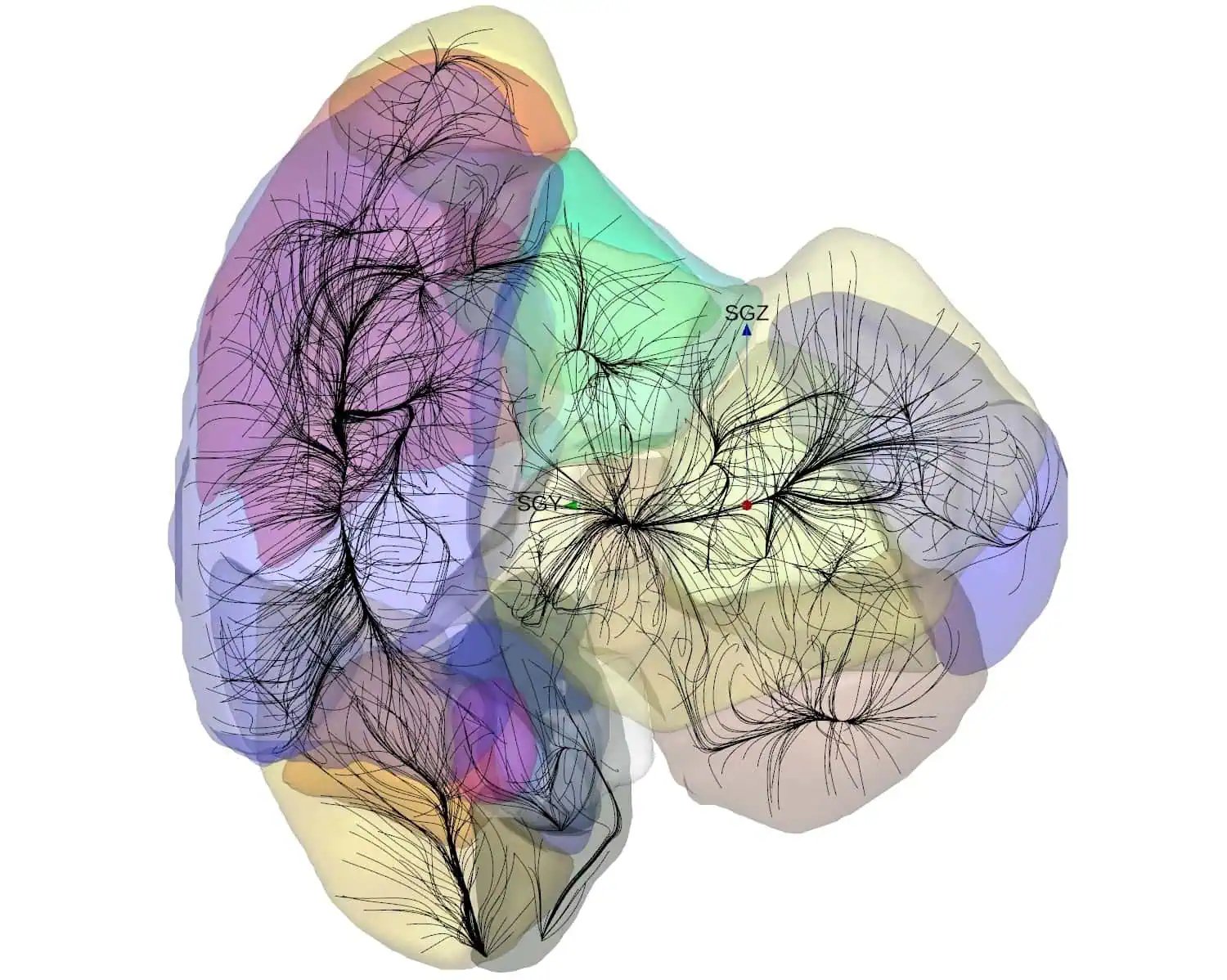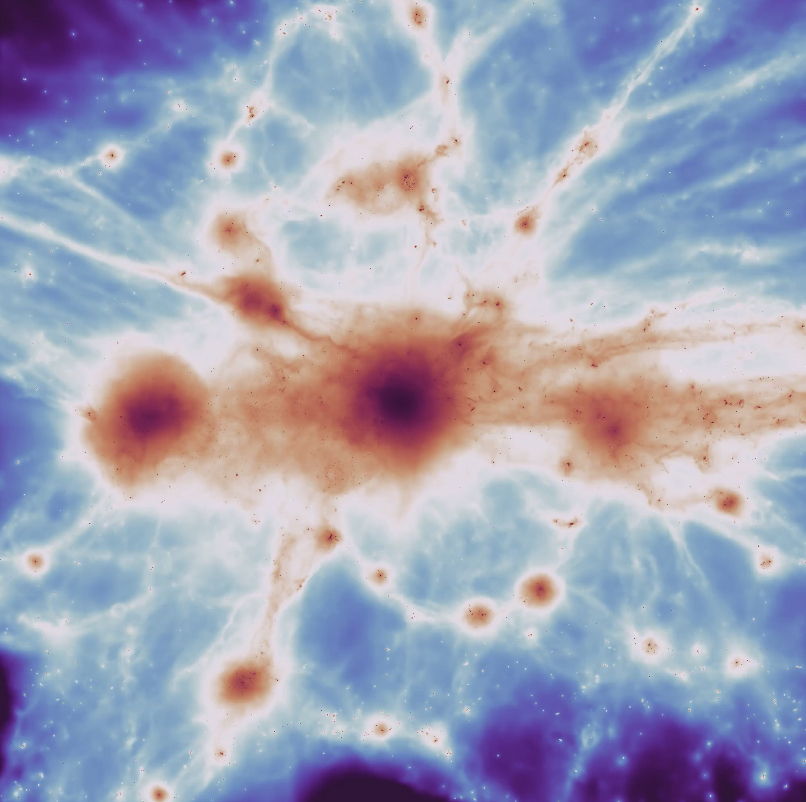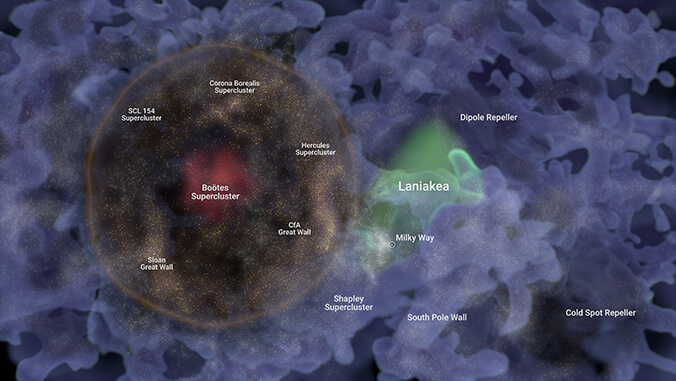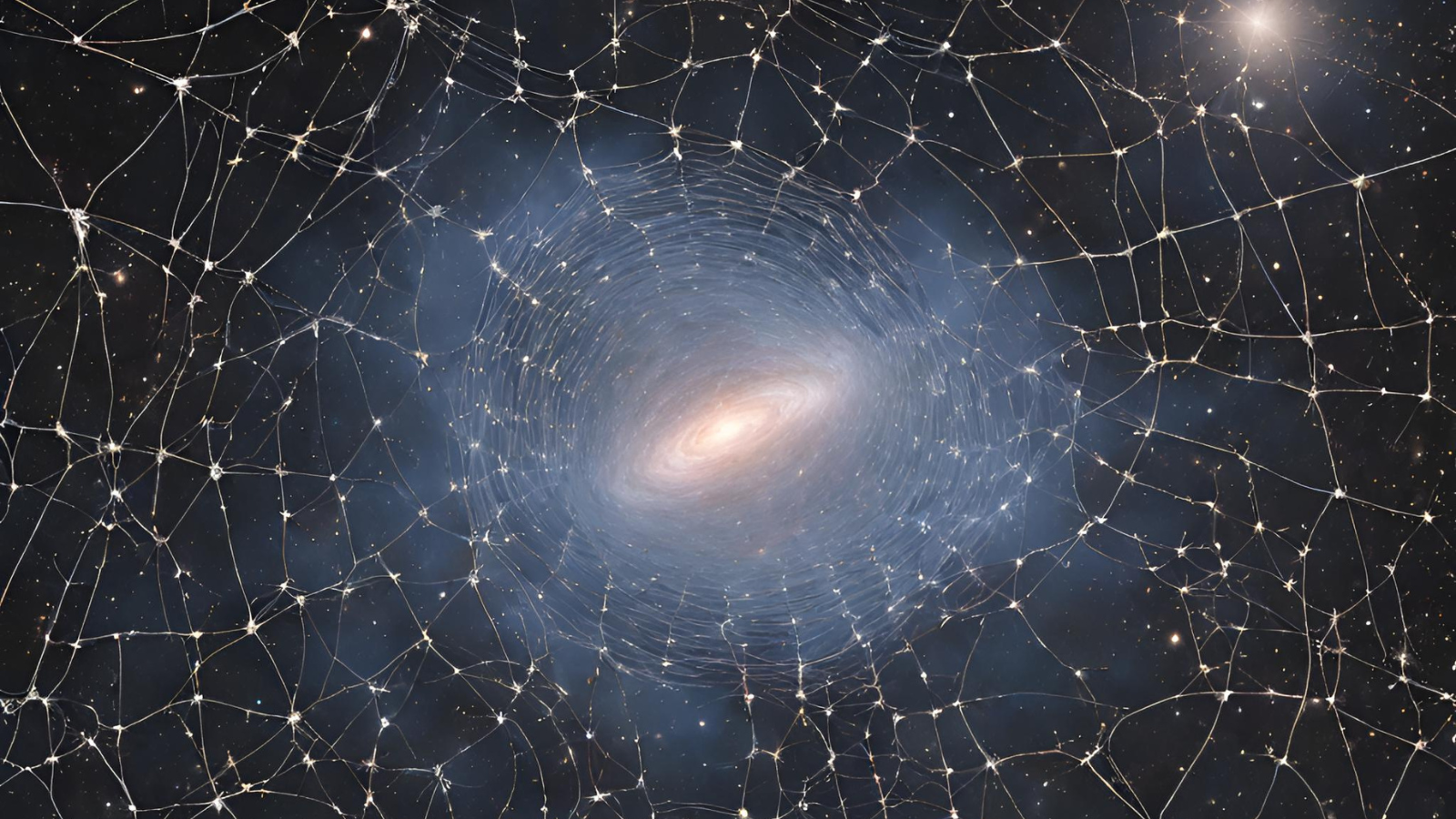How does the Cosmic Web connect Taylor Swift and the last line of your 'celestial address?'
"The overarching structure of the universe is the Cosmic Web, which you can imagine as a spider web, or a fishing net, in 3D. The basins of attraction are superimposed on this structure surrounding the knots of the web."

A new map of the "Cosmic Web" that shaped the universe shows points of gravitational attraction in the local universe called "basins of attraction" in hitherto unseen detail.
Created using information from the Cosmicflows-4 dataset, the new map defines basins of attraction or "gravitational wells" where gravity dominates and draws galaxies together in greater detail than ever before. The map also revealed a surprise about our home galaxy. Measuring the velocity and motion of 56,000 galaxies, the research reveals that our cosmic home, the Milky Way, is likely part of a 1,000 million light-year-wide basin of attraction called the Shapely Basin, which the Laniakea supercluster basin of attraction is being dragged toward.
These basins of attraction are vital to completing our "cosmic address," which begins with Earth, the solar system, the Milky Way, the Virgo cluster, the Virgo supercluster, Laniakea and the Shapely Basin, but lacks a final line. This last address on the cosmic envelope is the hypothetical largest structure in the universe, which scientists call the "End of Greatness."
"The overarching structure of the universe is the Cosmic Web, which you can imagine as a spider web, or a fishing net, in 3D," Daniel Pomarède, a cosmic map maker or "cosmographer" at the University Paris-Saclay told Space.com. "The basins of attraction are superimposed on this structure surrounding the knots of the web, their frontiers run through the voids located all around the knots, and these frontiers intersect the dark matter filaments joining two knots."
Related: How do galaxies grow while ensnared in the universe's cosmic web?
Of course, there are more colorful analogies than an out-of-this-world postal address. In a tweet on his X feed, the cosmic cartographer compared the newly produced map of the local universe and its basins of attraction to an outfit worn by Swift at the iHeartRadio Wango Tango concert in Carson, California, on June 1, 2019, referring to the singer-songwriter as a "cosmological icon."
Taylor Swift as a Basin of Attraction in the Local Universe pic.twitter.com/0HpeLEFBseOctober 4, 2024
Don't let this slightly frivolous comparison fool you; the study of these vast regions of space by Pomarède and the team is a serious business. That is because, as part of the Cosmic Web, these basins of attraction could reveal how galaxies like the Milky Way came together in larger gatherings and, thus, how the 13.8-billion-year-old universe took shape.
Breaking space news, the latest updates on rocket launches, skywatching events and more!
Your new 'cosmic address'
Pomarède should know all about cosmological superstardom. In 2014, he was one of the discoverers of the Laniakea supercluster, which verified the concept of basins of attraction. The discovery of Laniakea was made as part of a survey known as Cosmicflows-2, which at the time consisted of the largest-ever catalog of galaxies' motions.
This project mapped the velocities of galaxies as they recede from one another at a speed proportional to their relative distance, almost as if they were caught in a stream caused by the expansion of the universe, which astronomers call the "Hubble Flow."
"When we obtained our first maps using the Cosmicflows-2 catalog, a 3D region appeared inside which the cosmic flows converge onto the Great Attractor, near the Centaurus cluster of galaxies, in the direction our galaxy is moving," Pomarède said. "Beyond this, the cosmic flow converges on other, separate, neighbor attractors. This well-defined volume has a dimension of 500 million light-years, and we called it a basin of attraction and gave it the name Laniakea."
Subsequent maps revealed the existence of two other massive cosmic structures: the aforementioned Shapley Basin of Attraction and the Sloan Great Wall Basin of Attraction. Now, thanks to Cosmicflows-4, it appears that Laniakea is being drawn toward Shapley.
If the rapid inflation of the cosmos 13.8 billion years ago at the time of the Big Bang had occurred evenly across the entire cosmos, it would have resulted in a completely smooth or "homogenous" universe.
"The universe was born homogeneous and isotropic, having the same average properties everywhere and in all directions," Pomarède explained. "However, in the first fractions of a second, during the so-called 'Inflation phase,' tiny quantum fluctuations of the field driving the inflation created randomly distributed fluctuations of the density field."
These quantum fluctuations in density were dispersed and amplified by the rapid expansion of the universe. The result was that some regions became slightly overdense at the expense of other regions that became underdense.
"Matter flows from underdense to overdense regions, the basins of attraction, with the emptying regions becoming cosmic voids," Pomarède said. "The cosmic flows follow filaments that converge onto knots of the Cosmic Web, where we find large aggregates of matter, where galaxy clusters will form, hence the basins of attractions."
This results in a large-scale universe categorized by nodes along the Cosmic Web that contain thousands of galaxies, as well as voids that contain little matter and fewer galaxies with cosmic flows carrying matter from the former to the latter. Thus, though they may have started small, these fluctuations in density were vital, as without them, the universe would be homogenous and smooth, perhaps lacking congregations of matter like galaxies and galaxy clusters.
Hence, just as the flow of mighty rivers carved out geological features of Earth like the Grand Canyon, the cosmic flows carved out structures like galaxies, galaxy clusters, and superclusters.
"The associated velocities of galaxies are called 'peculiar velocities,' and they can be seen as deviations with respect to the Hubble Law, and we call these movements the cosmic flows," he continued. "What's fascinating is that these peculiar velocities contain precious information: they tell us what influences the galaxies are subject to; for instance, if they are located near a massive structure, their velocity vector will point to that structure. Our maps are obtained using this information."
The cosmic map maker explained that with the discovery of basins of attraction appeared a new way to map the universe, allowing scientists to segment the cosmos in adjacent cells and define their frontiers.
"That's pretty interesting, but what's amazing is, with this mapping technique, we can chart regions of the universe that are normally hidden from us because they are obscured by our own galaxy, the Milky Way," Pomarède said. "If there are structures hidden in these regions, they exert an influence on the galaxies in our astronomical catalogs; hence, we are able to map them."
This approach is already delivering surprises. The team was shocked when they made the serendipitous discovery of a spherical shell-like structure 1 billion light-years in diameter in the distribution of galaxies in the Cosmicflows-4 map. They speculate that this shell, which they named "Ho'oleilana," could be the remnant of an individual quantum fluctuation in the early universe.
Seeking the 'End of Greatness'
The importance of these basins of attraction is only matched by their staggering size. To put this into context, our home galaxy is around 100,000 light-years wide, and the distance to the closest galaxy to ours, Andromeda, is around 2 million light-years. Laniakea, on the other hand, is a staggering 500 million light-years wide and within it sits a mass equivalent to 100,000,000,000,000,000 suns!
The team has now found that Laniakea is moving toward the Shapely Basin, which is around twice its size at 1,000 million light-years wide.
"Thanks to this analysis, we found that there is a 40% probability that the Milky Way belongs to the Laniakea Basin of Attraction and 60% that it belongs to the Shapley Basin of Attraction," Pomarède said. "Besides the question of our home basin of attraction, we provided a map of numerous other basins of attraction, 15 of which have a probability greater than 50% to exist."
Staggeringly, it is thought that the Sloan Great Wall is even larger than these other two nodes of the Comic Web at a staggering 1.37 billion light-years wide. That reveals that even larger structures remain to be mapped, including the largest possible structure, the End of Greatness.
The team has twice improved on the Cosmicflows-2 catalog, which mapped 8,000 galaxies. In 2016, Cosmicflows-3 was based on the flow of 18,000 galaxies, and now, in 2024, the Cosmicflows-4 catalog details 56,000 galaxies. The project's ultimate aim is to search for the ultimate universal structure and the final line of every cosmic address.
Pomarède explained that the team wants to know if the observed size of the End of Greatness is compatible with the Standard Model of Cosmology. Basins of attraction provide a new way to look at this question as well as helping to determine the largest structure in the local universe to which we belong.
"On the other side of the cosmic distance scale, consider the size of the observable universe: 48 billion light-years in radius. You can fit a hell of a lot of basins of attraction inside that," Pomarède continued. "We keep expanding the map of the universe! The dominant basins of attraction identified here, Shapley, Hercules, Sloan Great Wall, and South Pole Wall, were all limited by the edges of our data. The current data are not deep enough to determine the outer bounds of these dominant basins of attraction, meaning they may very well be way bigger!
"In this research, we conclude we didn't reach the End of Greatness."
Pomarède explained the next steps in the ongoing search for the End of Greatness. Ironically, this will include focusing on the fine detail of these vast structures.
"We would like to look at specific issues. For example, the cosmography of the Sloan Great Wall Basin of Attraction," Pomarède concluded. "We didn't give any details on the content of this structure. We just know that it is associated with this 1.4 billion light-years long filament called the Sloan Great Wall, discovered in 2005. In the long term, there are many projects to obtain more peculiar velocities to expand our data."
The Cosmicflows-4-based research was published in the journal Nature Astronomy.

Robert Lea is a science journalist in the U.K. whose articles have been published in Physics World, New Scientist, Astronomy Magazine, All About Space, Newsweek and ZME Science. He also writes about science communication for Elsevier and the European Journal of Physics. Rob holds a bachelor of science degree in physics and astronomy from the U.K.’s Open University. Follow him on Twitter @sciencef1rst.





